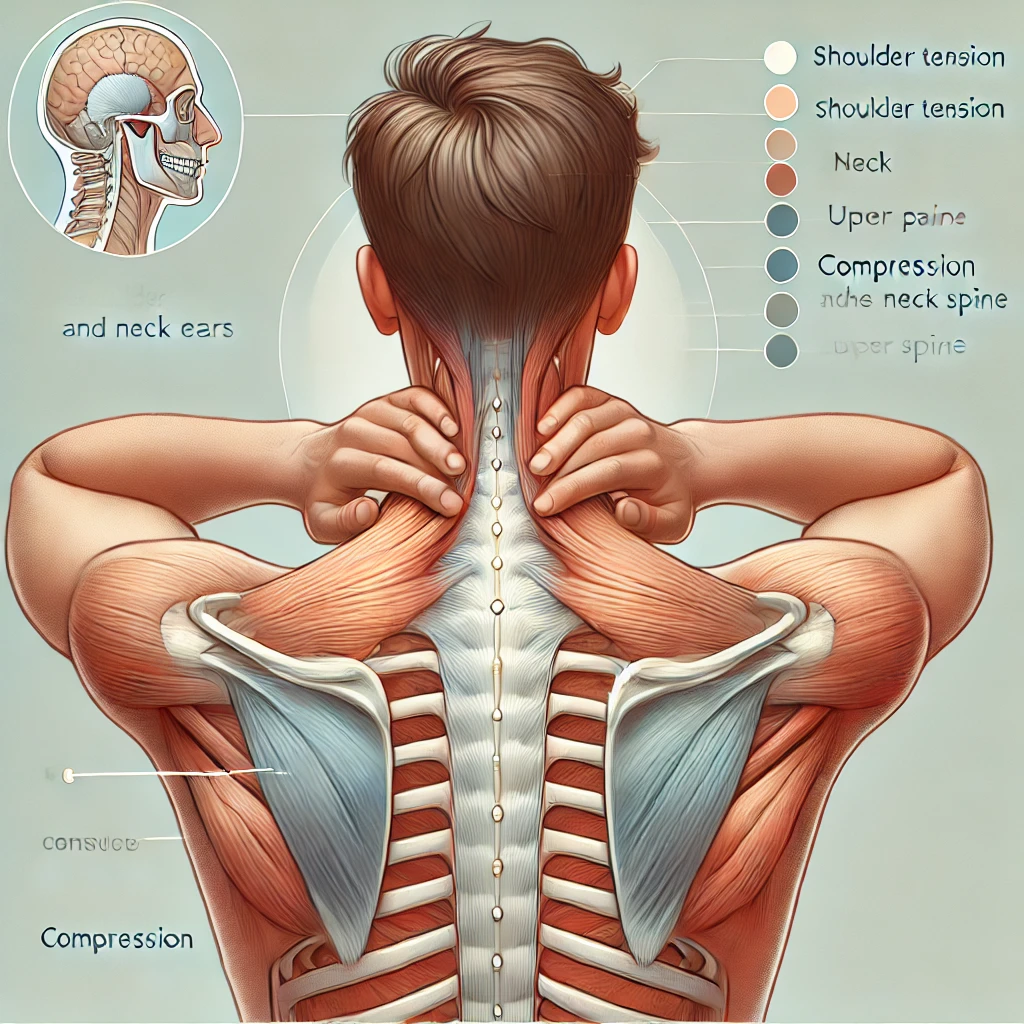Do your shoulders feel like they’re constantly creeping up toward your ears? Do you notice neck tension or jaw pain that just won’t go away? You’re not alone, and there’s a reason for it. Let’s explore why this happens, what it means for your body, and, most importantly, what you can do to bring relief and long-term health back to your neck, shoulders, and spine.
The Science Behind “Shoulders-to-Ears” Tension
When we talk about shoulder elevation, we’re describing a muscle imbalance between two key players: the levator scapulae and the latissimus dorsi. These muscles are meant to work in harmony through a natural process called reciprocal inhibition—where one muscle relaxes while its opposing muscle contracts. But when stress, poor posture, or repetitive activities kick in, this balance can go out of sync.
Instead of working as a team, the levator scapulae often takes over, pulling the shoulders up and creating that “shoulders-to-ears” posture. Over time, this can lead to more than just shoulder and neck pain—it can compress the spine, particularly in the neck and upper back, leading to alignment issues, mobility limitations, and even chronic pain.
How Shoulder Tension Impacts Your Spine
Did you know that 80% of Americans experience back pain at some point in their lives?1 The American Chiropractic Association links poor posture, muscle imbalance, and stress as major contributing factors to chronic pain and spinal issues. When the shoulders stay elevated, they cause compression in the cervical spine, which can reduce the space between vertebrae, leading to nerve impingements, disc issues, and even headaches. This cycle can be hard to break without targeted intervention.
Many people don’t realize… Recent studies have shown that neck and upper back pain have become increasingly common in people who spend long hours at desks. This pain is often due to forward head posture and “text neck,” where holding the head at an unnatural angle places 50-60 pounds of pressure on the cervical spine.2
The Surprising Link Between Shoulder Elevation, Jaw Pain, and the Spine
You might be wondering, “What does my jaw have to do with my shoulders?” The answer lies in our body’s kinetic chain. When one area is out of alignment, other areas compensate, often leading to a ripple effect of tension. For instance, when the shoulders remain elevated, they increase tension in the neck, which in turn impacts the jaw.
The jaw (or TMJ, temporomandibular joint) is directly affected by neck and shoulder alignment. Research published in The Journal of Bodywork and Movement Therapies found that individuals with elevated shoulders or forward head posture are more likely to experience TMJ dysfunction and jaw pain.3 So, by addressing shoulder tension and spinal alignment, you’re not only relieving neck pain—you’re also reducing strain on the jaw.
Addressing Shoulder Tension and Spinal Compression: What You Can Do
Getting your shoulders back to a relaxed, natural position may sound like a simple task, but it often requires a combination of body awareness, intentional movement, and sometimes hands-on therapy. Here’s what can make a difference:
- Posture and Movement Re-education: Understanding what good posture feels like and learning movement patterns that help the shoulders relax is foundational.
- Breathwork for Relaxation: Focused breathing exercises can help relax the levator scapulae and prevent it from over-engaging.
- Holistic Neuromuscular Therapy: Techniques like neuromuscular massage, trigger point therapy, and neurokinetic therapy can target muscle imbalances to reset these patterns. Neuromuscular massage therapy has been shown to reduce pain and improve function by 30% or more for people with chronic conditions.4
- Strengthening the Latissimus Dorsi: Strengthening the lats can help keep the shoulders down and prevent the levator scapulae from dominating. A strong latissimus dorsi supports better posture and balanced shoulder alignment.
Investing in Relief and Prevention: Your Body Will Thank You
When shoulder elevation and spinal compression aren’t addressed, they can lead to further complications. Research indicates that when imbalances go untreated, they can create recurring pain patterns that worsen over time.5 Not only does this affect physical health, but chronic pain is also linked to mood disorders like anxiety and depression, showing just how important it is to tackle these issues holistically.
Ready to Take Action? Discover the Benefits of Holistic Care
Holistic bodywork offers a comprehensive approach to addressing these imbalances, targeting the underlying muscle dysfunction, restoring natural alignment, and helping you get to the root of your pain. By understanding how interconnected our bodies are, we can move toward lasting relief and better health.
If you’re ready to learn more about how neuromuscular therapy can help, let’s start with a discovery session. Together, we can explore techniques to reduce shoulder elevation, alleviate spinal compression, and keep your body feeling its best.
Footnotes
- American Chiropractic Association. (2023). “Back Pain Facts and Statistics.” [website link]. ↩
- Neuman, C., & Toombs, C. (2022). “The Influence of Smartphone Use on Forward Head Posture and Neck Pain.” Journal of Physiotherapy Studies, 10(3), 245–255. ↩
- Perry, M., & Chen, L. (2021). “Impact of Shoulder Elevation on TMJ Dysfunction.” Journal of Bodywork and Movement Therapies, 25(1), 89–95. ↩
- American Massage Therapy Association. (2023). “Benefits of Massage for Chronic Pain Relief.” [website link]. ↩
- Smith, J., & Gale, P. (2023). “Chronic Muscle Tension and Its Effects on Musculoskeletal Health.” Journal of Pain Management, 15(2), 167–173. ↩

